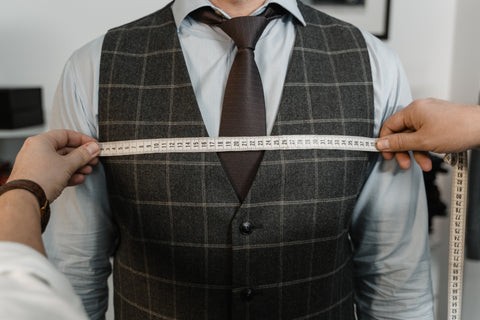Finding the right size dress shirt can often feel like navigating a maze. With numerous brands, cuts, and sizing conventions, it’s understandable to feel overwhelmed. But don’t worry, as your trusted fashion expert, I’m here to demystify men’s dress shirt sizing and guide you to the perfect fit. This comprehensive men’s dress shirt sizing guide will break down everything you need to know, from understanding different sizing systems to taking accurate measurements. By the end of this guide, you’ll be equipped to choose dress shirts that not only fit impeccably but also elevate your style.
Navigating the world of men’s dress shirt sizes can be complex due to the variety of sizing systems employed by different brands. Primarily, you’ll encounter two main sizing types: alpha and numeric. Each offers a distinct approach to determining your ideal fit, and understanding the nuances of both is key to choosing the right shirt.
Alpha sizing is frequently used for more casual shirts and sometimes for relaxed-fit dress shirts. This system uses letters, typically ranging from XS to XXL (and sometimes beyond), where each letter corresponds to a broader range of body measurements. For instance, a size Small (S) might generally fit chest sizes from 34-36 inches. While alpha sizing offers simplicity, it’s less precise for dress shirts where a tailored fit is often desired.
Numeric sizing, conversely, is the standard for most dress shirts and provides a more precise fit. This system is based on two key measurements: neck size and sleeve length, both usually indicated in inches. A typical numeric size is presented as two numbers separated by a slash, such as 15.5/34. The first number represents the neck circumference in inches, and the second number indicates the sleeve length, also in inches. This dual measurement system ensures a more customized fit, particularly crucial for dress shirts worn in professional or formal settings.
Understanding Dress Shirt Size Charts and Measurements
To accurately determine your dress shirt size, taking precise body measurements is essential. Most men’s dress shirt size charts rely on neck and sleeve length measurements. While some charts may also include chest and waist measurements, neck and sleeve are the foundational metrics for numeric sizing. It’s crucial to remember that sizing can vary slightly between brands. Therefore, always consult the specific men’s dress shirt size guide provided by the brand you are considering before making a purchase. These guides often include detailed charts and instructions tailored to their specific sizing standards.
| Size | Neck (inches) | Sleeve (inches) | Chest (inches) |
|---|---|---|---|
| Small (S) | 14 – 14.5 | 32 – 33 | 34 – 36 |
| Medium (M) | 15 – 15.5 | 33 – 34 | 38 – 40 |
| Large (L) | 16 – 16.5 | 34 – 35 | 42 – 44 |
| Extra Large (XL) | 17 – 17.5 | 35 – 36 | 46 – 48 |
| XXL | 18 – 18.5 | 36 – 37 | 50 – 52 |




To ensure you find your ideal fit, always refer to the relevant men’s dress shirt size chart for the sizing system you are using. These charts provide specific measurements for each size, including neck, sleeve, and chest dimensions. Accurate men’s dress shirt measurements are the cornerstone of selecting the correct size.
In addition to size charts, many brands offer comprehensive men’s dress shirt size guides that provide detailed instructions on taking measurements and choosing the most suitable size for your body type and preferred fit. These guides are invaluable resources for online shopping and ensuring satisfaction with your purchase.
How to Measure Yourself for a Dress Shirt
Understanding how men’s dress shirt measurements are taken is the first step to finding your perfect size. As a fashion expert, I’ll walk you through measuring each key area accurately.
1. Neck Measurement: This is arguably the most crucial measurement for dress shirts as it determines collar comfort. To measure your neck size, take a flexible measuring tape and wrap it around your neck at the base, where your collar would naturally sit. Ensure the tape is level and comfortably snug, not too tight. It’s often recommended to insert a finger between the tape and your neck to ensure a comfortable fit that isn’t too restrictive.
2. Sleeve Length Measurement: Sleeve length is measured from the center of your back (at the base of your neck) over your shoulder and down to your wrist bone. To get an accurate measurement, slightly bend your arm at the elbow. This ensures the sleeve length will be comfortable when you move. Have someone assist you with this measurement for best results, or use a mirror to help guide you.
3. Chest Measurement: Measure around the fullest part of your chest, keeping the measuring tape horizontal and positioned under your arms. Relax your arms at your sides while taking this measurement. Ensure the tape is snug but not constricting. This measurement helps determine the overall fit of the shirt across your chest and shoulders.
4. Waist Measurement (Optional for Standard Fit): For a more tailored or fitted look, waist measurement is important. Measure around your natural waistline, which is typically located just above your belly button. Keep the tape comfortably snug. While not always specified in standard size charts, waist measurements are crucial for slim-fit or tailored dress shirts.
By taking these measurements and consulting a men’s dress shirt size chart or guide, you can confidently select the right size for your body type and desired fit.
Choosing the Right Dress Shirt Size and Fit
Selecting the correct dress shirt size is paramount for a polished and sophisticated appearance. Begin by using your neck measurement as the primary guide. If your neck measurement falls between sizes, it’s generally advisable to round up to the next half inch for comfort. Next, consider your sleeve length to ensure the cuffs fall appropriately at your wrists, typically ending where your hand meets your wrist.
Beyond measurements, consider your body type and desired fit. Pick a shirt style that complements your physique and personal preference. Dress shirts come in various fits, including classic fit (roomier), slim fit (more tailored), and modern fit (a balance between classic and slim). A well-fitted dress shirt should feel comfortable, allow for a full range of motion, and present a clean, streamlined silhouette.
Conclusion: Dress to Impress with the Perfect Fit
Finding the right men’s dress shirt size doesn’t have to be a struggle. By understanding sizing systems, taking accurate measurements using a men’s dress shirt sizing guide, and considering your body type and preferred fit, you can choose dress shirts that fit you flawlessly. Remember, the foundation of a sharp and stylish outfit begins with properly fitted clothing. Invest time in understanding your size, and you’ll elevate your wardrobe and your confidence. Accurate men’s dress shirt measurements are indeed the cornerstone of a sophisticated and dashing look.
Frequently Asked Questions (FAQs)
– How are men’s dress shirts sized?
Men’s dress shirts are primarily sized using neck size and sleeve length measurements. Neck size is measured around the base of the neck, and sleeve length is measured from the center of the back of the neck to the wrist bone.
– How do men’s dress shirt sizes work?
Men’s dress shirt sizes typically use numeric measurements for neck and sleeve length. The neck size determines the collar circumference, while sleeve length dictates where the cuff falls on the arm. Common sizes are expressed in inches, such as 15.5/34, indicating a 15.5-inch neck and 34-inch sleeve length. Alpha sizing (S, M, L, XL) is less precise and generally used for casual shirts or broader sizing categories.

